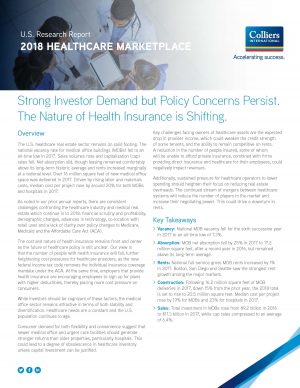Strong Investor Demand but Policy Concerns Persist. The Nature of Health Insurance is Shifting.
Overview
 The U.S. healthcare real estate sector remains on solid footing. The national vacancy rate for medical office buildings (MOBs) fell to an all-time low in 2017. Sales volumes rose and capitalization (cap) rates fell. Net absorption slid, though leasing remained comfortably above its long-term historic average and rents increased marginally at a national level. Over 16 million square feet of new medical office space was delivered in 2017. Driven by rising labor and materials costs, median cost per project rose by around 20% for both MOBs and hospitals in 2017.
The U.S. healthcare real estate sector remains on solid footing. The national vacancy rate for medical office buildings (MOBs) fell to an all-time low in 2017. Sales volumes rose and capitalization (cap) rates fell. Net absorption slid, though leasing remained comfortably above its long-term historic average and rents increased marginally at a national level. Over 16 million square feet of new medical office space was delivered in 2017. Driven by rising labor and materials costs, median cost per project rose by around 20% for both MOBs and hospitals in 2017.
As noted in our prior annual reports, there are consistent challenges confronting the healthcare industry and medical real estate which continue in to 2018: financial scrutiny and profitability, demographic changes, advances in technology, co-location with retail uses and a lack of clarity over policy changes to Medicare, Medicaid and the Affordable Care Act (ACA).
The cost and nature of health insurance remains front and center as the future of healthcare policy is still unclear. Our view is that the number of people with health insurance will fall, further heightening cost pressures for healthcare providers, as the new federal income tax code removes the individual insurance coverage mandate under the ACA. At the same time, employers that provide health insurance are encouraging employees to sign up for plans with higher deductibles, thereby placing more cost pressure on consumers.
While investors should be cognizant of these factors, the medical office sector remains attractive in terms of both stability and diversification. Healthcare needs are a constant and the U.S. population continues to age.
Consumer demand for both flexibility and convenience suggest that newer medical office and urgent care facilities should generate stronger returns than older properties, particularly hospitals. This could lead to a degree of obsolescence in healthcare inventory unless capital investment can be justified.
Key challenges facing owners of healthcare assets are the expected drop in provider income, which could weaken the credit strength of some tenants, and the ability to remain competitive on rents. A reduction in the number of people insured, some of whom will be unable to afford private insurance, combined with firms providing direct insurance and healthcare for their employees, could negatively impact revenues.
Additionally, sustained pressure for healthcare operators to lower spending should heighten their focus on reducing real estate overheads. The continued stream of mergers between healthcare systems will reduce the number of players in the market and increase their negotiating power. This could drive a downturn in rents.
Key Takeaways
>> Vacancy: National MOB vacancy fell for the sixth successive year in 2017 to an all-time low of 7.3%.
>> Absorption: MOB net absorption fell by 25% in 2017 to 17.2 million square feet, after a record year in 2016, but remained above its long-term average.
>> Rents: National full-service gross MOB rents increased by 1% in 2017. Boston, San Diego and Seattle saw the strongest rent growth among the major markets.
>> Construction: Following 16.2 million square feet of MOB deliveries in 2017, down 15% from the prior year, the 2018 total is set to rise to 20.5 million square feet. Median cost per project
rose by 19% for MOBs and 23% for hospitals in 2017.
>> Sales: Total investment in MOBs rose from $9.2 billion in 2016 to $11.3 billion in 2017, while cap rates compressed to an average of 6.4%.
The full content of this article is only available to paid subscribers. If you are an active subscriber, please log in. To subscribe, please click here: SUBSCRIBE





